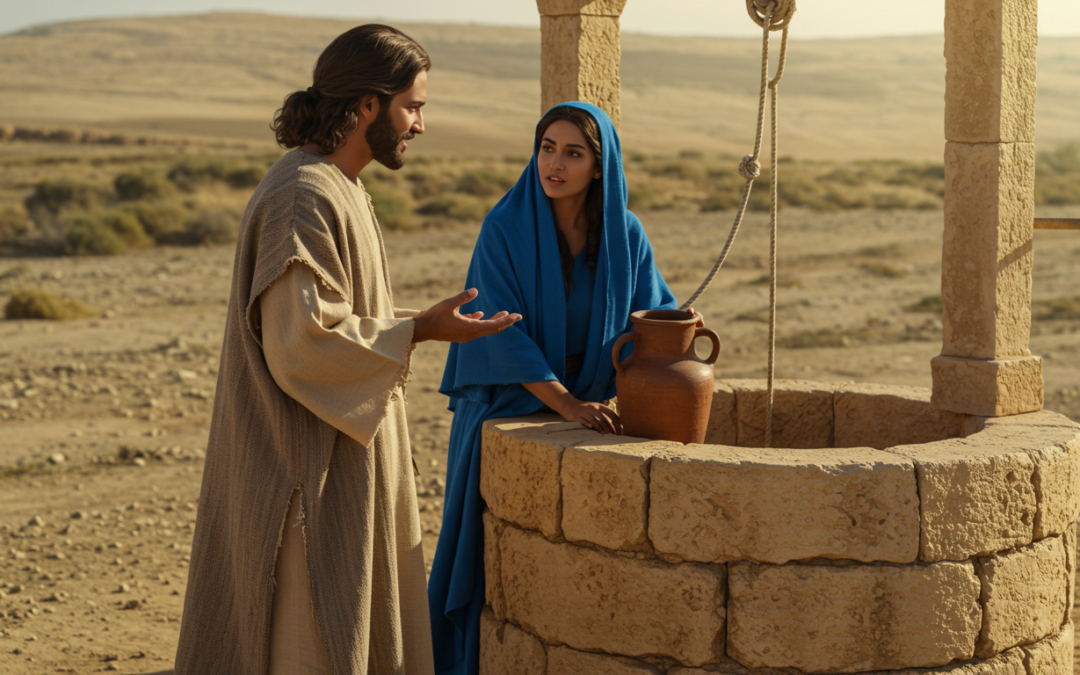Growing up in the church, I learned all the Bible stories. From the great flood and the parting of the Red Sea to the parables Jesus told, the stories were ingrained in my mind and heart from a young age.
I knew the characters, memorized the verses, and listened to countless sermons. Yet, despite the hours spent in Sunday school and church services, something was missing. I understood the stories at face value, but the deeper spiritual meanings eluded me.
It wasn’t until I began my journey into self-discovery and enlightenment that these ancient tales took on new significance. One story that profoundly transformed my perspective is the encounter between Jesus and the Samaritan woman at the well.
Traditionally, this story is often framed as a lesson in evangelism, a call to spread the good news far and wide.
But as I searched for deeper spiritual truths, I realized it’s so much more than that. This is a story of personal awakening, an invitation from Jesus to the woman—and to all of us—to experience enlightenment and self-actualization.
The Story and Its Surface Meaning
In the Gospel of John, Jesus, weary from his travels, stops at a well in Samaria. There he meets a woman drawing water, and an unexpected conversation unfolds. In those days, Jews and Samaritans didn’t interact, and men rarely spoke to women in public.
But Jesus broke all social and cultural norms, asking her for a drink and offering her “living water.” Their dialogue soon shifts to the woman’s personal life, with Jesus acknowledging her complicated past and gently guiding her toward a spiritual truth that she’d never encountered before.
As a child, I saw this as just another example of Jesus’ ability to love and forgive. But now, as I read it through the lens of spiritual enlightenment, I see how deeply Jesus was teaching the path to wholeness and self-realization.
Metaphysical Symbolism and Spiritual Lessons
From a metaphysical perspective, the story is a profound exploration of the soul’s journey toward self-awareness and divine connection. Here are some of the symbolic elements that stand out:
1. The Well as the Subconscious Mind: Wells are places of depth, holding water beneath the surface. They represent the subconscious mind, where our deepest thoughts, beliefs, and unhealed emotions lie.
The woman coming to draw water symbolizes our quest for sustenance—often seeking external solutions for internal thirst. Yet, Jesus introduces her to a different kind of water: living water, representing spiritual truth and enlightenment.
2. Water as Divine Nourishment: Water is a common spiritual symbol, representing the flow of divine energy and the essence of life.
When Jesus speaks of living water, he invites the woman to discover the divine source within her, a wellspring that never runs dry. It is a call to move beyond the surface-level distractions of life and connect with eternal spiritual truths.
3. Jesus as the Christ Consciousness: Jesus embodies Christ consciousness, a state of spiritual enlightenment and unconditional love.
His interaction with the woman demonstrates the nonjudgmental, compassionate nature of this higher awareness. He sees her as she is, past and present, and calls her to step into a new understanding of herself without shame or guilt.
4. The Samaritan Woman as the Seeker: The woman represents each of us, especially in our moments of feeling unworthy, isolated, or burdened by our past.
Her encounter with Jesus symbolizes the soul’s readiness for transformation, even if it comes unexpectedly. She comes to the well for physical water and leaves with a profound spiritual awakening.
An Invitation to Wholeness
The lesson here isn’t just about religious conversion or evangelism. It’s about Jesus inviting the woman—and every human being—into an experience of enlightenment and self-actualization.
He doesn’t shame her for her past but instead uses it as a bridge to deeper spiritual truths. By acknowledging and integrating her shadow self, the woman experiences healing and transformation, becoming an empowered vessel of divine love and wisdom.
Jesus’ message is clear: spiritual awakening is for everyone, even those society has written off or shamed.
The living water he offers is a metaphor for the divine essence within each of us, waiting to be tapped into. This is a call to explore our depths, heal our wounds, and live from a place of spiritual abundance.
How We Can Apply This Lesson
1. Seeking the Living Water Within: In our fast-paced world, we often look for external solutions to internal struggles—whether through relationships, achievements, or material comforts.
This story challenges us to go within and nourish our spirits. Meditation, prayer, journaling, and other contemplative practices can help us connect to this inner source.
2. Embracing All Parts of Ourselves: Like the Samaritan woman, we all have aspects of our past we might feel ashamed of. But healing begins when we acknowledge and integrate those parts without judgment.
This self-acceptance allows for deeper healing and wholeness.
3. Breaking Down Divisions: The story transcends cultural and social barriers, emphasizing the oneness of all humanity.
By practicing compassion and releasing judgment, we can create a sense of unity with others, recognizing that we are all on unique spiritual paths.
4. Becoming Vessels of Enlightenment: When we experience spiritual awakening, we naturally inspire others.
The woman at the well became a source of hope for her community. In the same way, our journeys can serve as beacons for those around us, showing that transformation and healing are possible.
My Personal Transformation
This story has become a powerful metaphor for my own spiritual journey. From growing up in the church to seeking enlightenment beyond religious dogma, I’ve learned that true spiritual nourishment doesn’t come from external validation but from a deep, inner connection to the divine.
The story of Jesus and the Samaritan woman reminds us that no matter our past or the labels society places on us, we are all invited to drink from the well of divine truth. We are all worthy of enlightenment, self-actualization, and spiritual wholeness.
So the next time you feel spiritually thirsty, remember that the living water you seek is already within you. All it takes is a willingness to go deeper, to meet yourself at the well, and to embrace the fullness of who you are.

